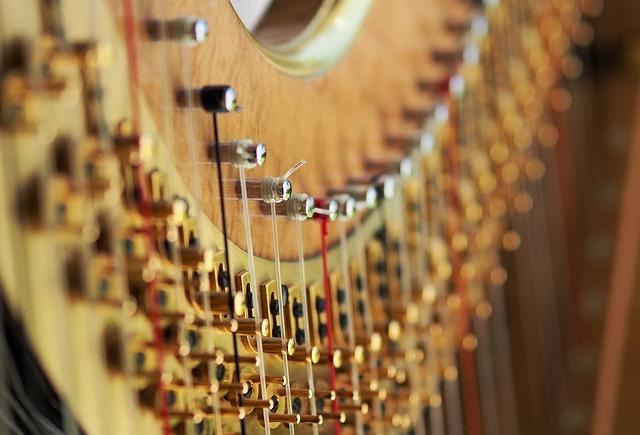Imagine walking into a room filled with vibrant colors, each hue blending seamlessly into the next. That’s the world of pitch in music—a spectrum of sound where every note plays a vital role in creating harmony. Just as a painter carefully selects each color to evoke emotion and narrative, musicians meticulously choose pitches to weave together melodies that resonate with listeners. But what exactly is pitch, and why is it so fundamental to our musical experience? In this article, we’ll explore the intricacies of pitch, discover its significance in the realm of harmony, and unravel how these elements come together to form the soundscapes that move us. Whether you’re a seasoned musician or a casual listener, understanding pitch can transform your appreciation of music, unlocking the secrets behind your favorite tunes. So, let’s dive into this melodic journey and uncover the heartbeats of harmony that drive the rhythm of our lives!
Exploring the Basics of Pitch and Its Role in Music Composition

At its core, pitch is what gives music its essence; it’s the very fabric that weaves melodies into memorable tunes. When you think about pitch, imagine a vast landscape of sound where each note represents a different point of interest. Just like colors on a painter’s palette, each pitch adds depth and emotion to a composition. Higher pitches can evoke feelings of joy and excitement, while lower pitches often bring a sense of warmth or melancholy. Understanding how to manipulate pitch allows composers to craft songs that resonate with listeners on a deeper level.
<p>In music, pitch isn’t just about the individual notes; it’s also about how these notes interact with one another. Consider this: when notes harmonize, they create relationships that can heighten the overall impact of a piece. By utilizing concepts like intervals, scales, and tuning systems, composers can explore a rich tapestry of possibilities. Here are a few key elements to keep in mind:</p>
<ul>
<li><strong>Intervals:</strong> The distance between two pitches; they can be major, minor, or perfect.</li>
<li><strong>Scales:</strong> A sequence of pitches in ascending or descending order; think of them as the roadmap of your composition.</li>
<li><strong>Tuning Systems:</strong> Variations in pitch organization that can change the character of music, from Western to Eastern traditions.</li>
</ul>
<table class="wp-block-table">
<thead>
<tr>
<th>Type of Interval</th>
<th>Example</th>
<th>Emotional Impact</th>
</tr>
</thead>
<tbody>
<tr>
<td>Major</td>
<td>C to E</td>
<td>Cheerful</td>
</tr>
<tr>
<td>Minor</td>
<td>A to C</td>
<td>Sombre</td>
</tr>
<tr>
<td>Perfect</td>
<td>C to G</td>
<td>Stable</td>
</tr>
</tbody>
</table>
The Science Behind Pitch: Frequencies, Waves, and Human Perception

When we dive into the realm of pitch, we’re actually navigating through a fascinating playground of frequencies and waves. At the core, pitch refers to how high or low a sound appears to our ears, and this is determined by the frequency of the sound wave emanating from an instrument or voice. The frequency is measured in Hertz (Hz), indicating how many times a wave oscillates per second. For instance, middle C on a piano typically vibrates at around 261.63 Hz. Sounds with higher frequencies create a sensation of a higher pitch, while lower frequencies contribute to deep, resonating tones. It’s like imagining a rollercoaster; as you ascend to the peaks, everything feels light and exhilarating, much like the sharper sounds of a flute, whereas the descent brings you into a comforting, rich base like that of a cello.
But it gets even more intriguing when we consider how humans perceive these frequencies. Our ears are finely tuned instruments, capable of detecting a broad range of pitches, roughly from 20 Hz to 20,000 Hz. Within this range, our sensitivity varies; we’re most attuned to frequencies between 1000 Hz and 4000 Hz, which is where most of the sounds in human speech lie. Here’s a simple table to illustrate some common frequencies and their associated pitches:
| Pitch Name | Frequency (Hz) |
|---|---|
| Middle C | 261.63 |
| A4 (Concert A) | 440 |
| E5 | 659.25 |
| B4 | 493.88 |
This intricate dance of sound waves and frequencies not only entertains but also plays a crucial role in the harmony of music. Just imagine a painter blending colors; each frequency works together to create vibrant chords and melodies that speak to the soul. The beauty of music lies in this science, making pitch a foundational element of the art we cherish.
Harmonizing with Pitch: Techniques for Musicians and Composers

When it comes to crafting melodies and harmonies, understanding pitch is like having the map to a vast musical landscape. For musicians and composers alike, mastering pitch ensures that every note resonates with intent. Here are some effective techniques to harmonize with pitch:
- Interval Recognition: Knowing how different notes relate to each other harmonically can vastly improve your compositions. Familiarize yourself with intervals like thirds, fifths, and octaves. They’re the building blocks of harmony.
- Experiment with Scales: Different scales offer unique emotional flavors. Try using major, minor, and modal scales to discover new harmonic possibilities that suit the mood you’re aiming for. Each scale unlocks a treasure trove of options!
- Use Chord Progressions: Classic progressions like the I-IV-V or ii-V-I format serve as a strong foundation. These staple sequences provide a framework for creating interesting harmonies.
| Scale Type | Emotion |
|---|---|
| Major | Happiness, Joy |
| Minor | Sadness, Melancholy |
| Dorian | Hopeful, Reflective |
| Pentatonic | Peaceful, Simplicity |
Diving further into these techniques can help musicians and composers refine their skills, ensuring that every note aligns perfectly with their artistic vision. Remember, the beauty of music lies in the journey—from chaos to harmony, where each pitch finds its rightful place, resonating across the hearts of listeners. Don’t shy away from exploring unconventional sounds; sometimes the most striking harmonies emerge from unexpected pitch combinations. Embrace the process, and let the magic of pitch guide your creativity!
Cultivating Your Ear: Practical Exercises to Enhance Pitch Recognition
Developing pitch recognition can feel like learning a new language—it takes practice, patience, and a sprinkle of creativity. One great way to sharpen your ear is through interval training. Start by playing two notes, either on a piano or with a digital app, and try to identify the distance between them. You can mix up the intervals—some may be bright and cheery like a perfect fifth, while others might sound more mysterious and moody like a minor sixth. Try recording these intervals and play them back while you hum or sing to figure out their names. This exercise not only sharpens your pitches but also enhances your ability to understand melodies and harmonies. Remember, repetition is key; the more you do it, the easier it becomes to recognize different pitches effortlessly!
Another fun exercise to engage your pitch recognition is the “Call and Response” method. Find a friend or use an online platform that lets you listen to a note being played and then tries to replicate it. Start with single notes, then gradually progress to short melodies. This interactive approach creates a musical dialogue—a bit like having a conversation where you’re both trying to match each other’s tone and rhythm. If you want to spice things up a bit, consider keeping a small notebook where you jot down your progress or any particularly challenging notes. Creating a simple table to track which intervals or notes you struggle with can provide additional motivation and clarity in your practice. For example:
| Interval | Difficulty Level | Practice Notes |
|---|---|---|
| Perfect Fifth | Easy | Recognize immediately. |
| Minor Sixth | Medium | Struggling to identify. |
| Augmented Fourth | Hard | Very tricky, needs more repetition. |
Key Takeaways
As we wrap up our journey through the fascinating world of pitch in music, it’s clear that understanding this cornerstone of harmony can transform the way we experience sound. Like the threads in a tapestry, each pitch weaves together to create the intricate patterns of melody and rhythm that resonate within us. Whether you’re a seasoned musician or just dipping your toes into the musical waters, grasping the nuances of pitch enhances not only your performance but also your appreciation for the art.
Think of pitch as the vibrant colors on an artist’s palette; each one adds depth, emotion, and meaning to a composition. So, the next time you listen to your favorite song, pay close attention to the pitches at play and let the layers of harmony wash over you. Who knows? You might just find yourself dancing to a different tune, with a deeper understanding of the music that moves us all. Keep exploring, keep listening, and remember that the world of pitch is vast and full of surprises—just waiting for you to uncover its magic!



